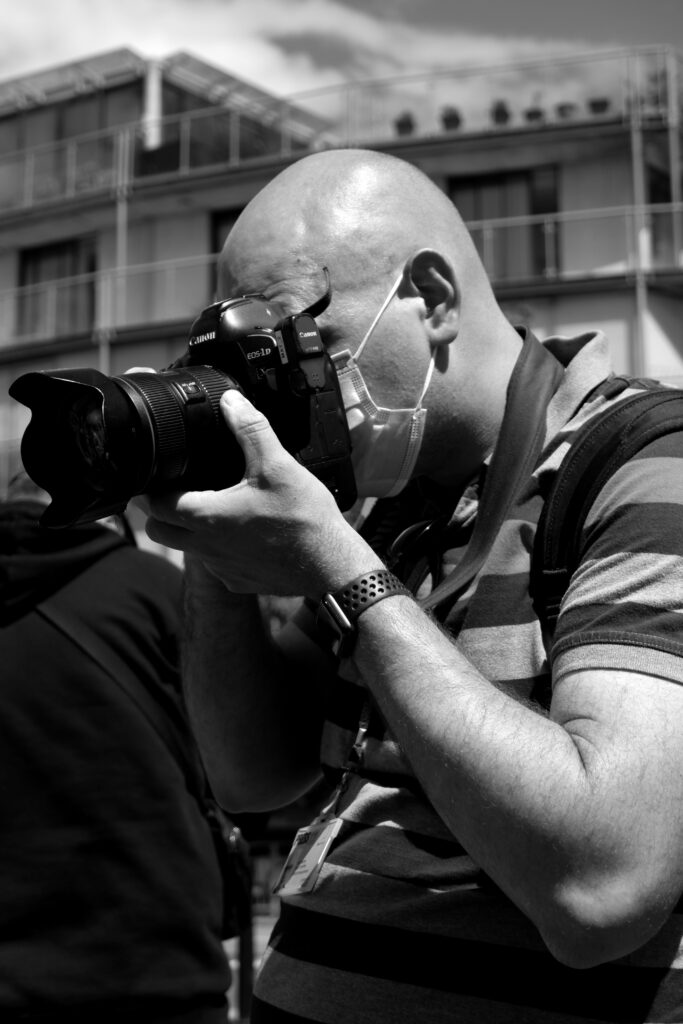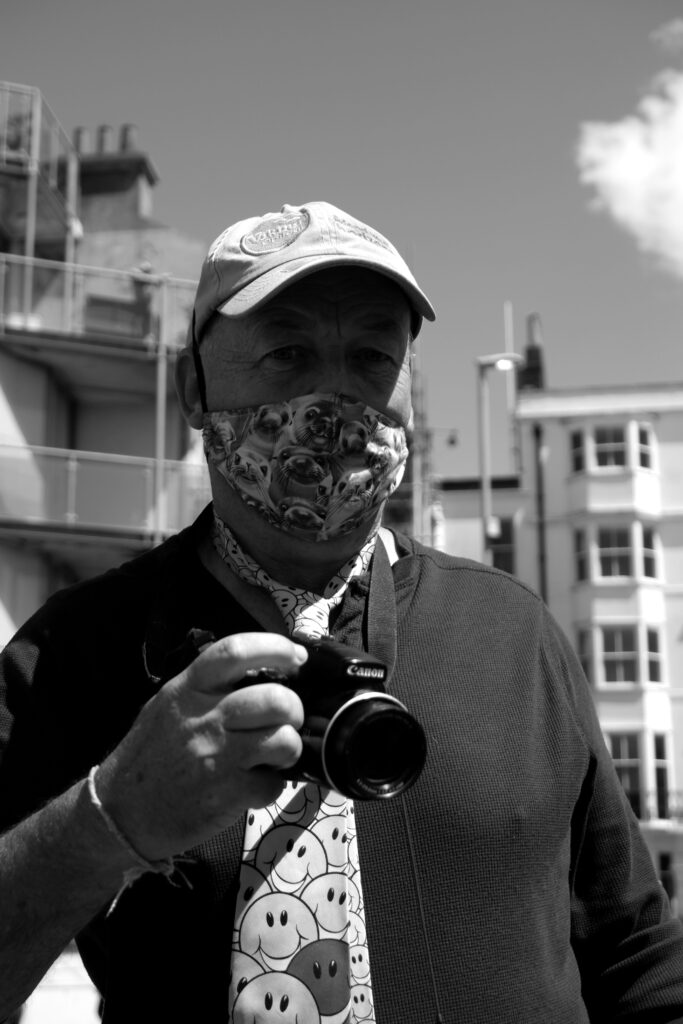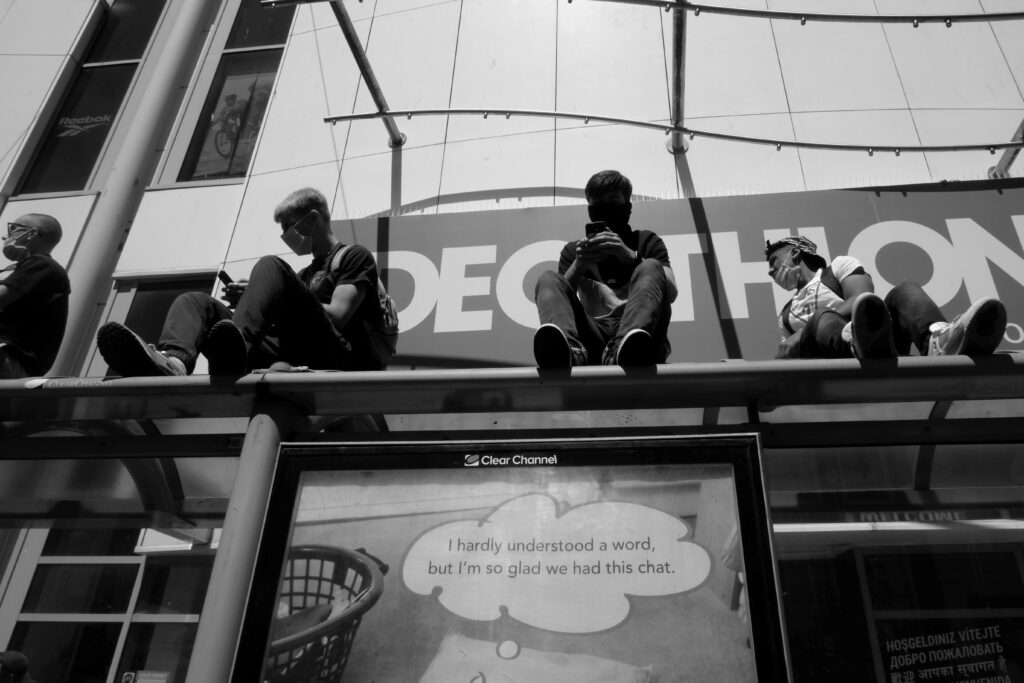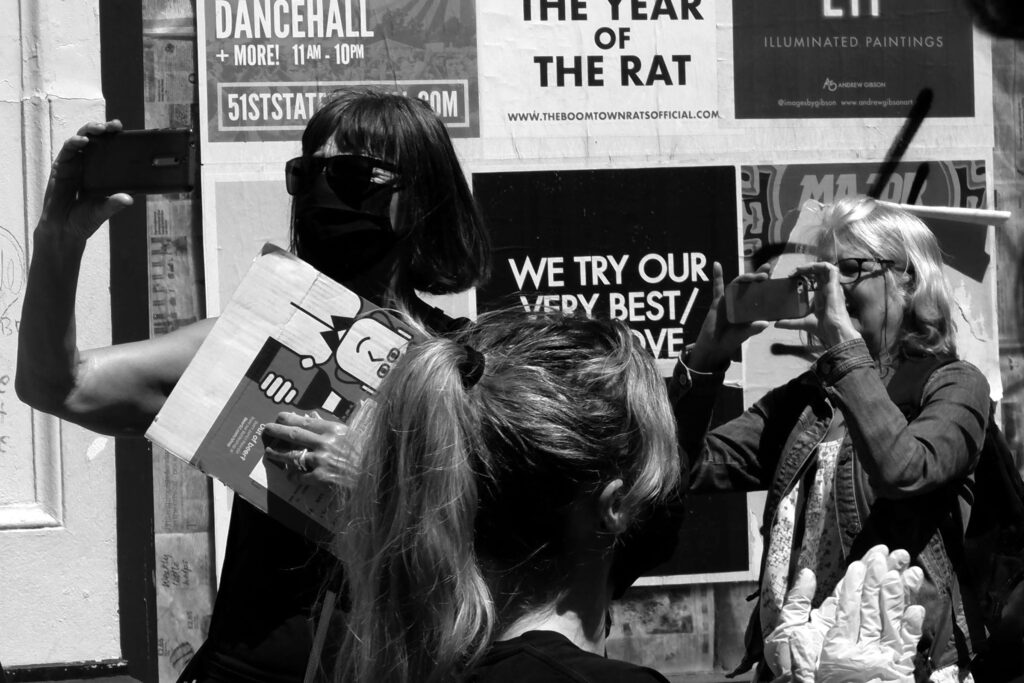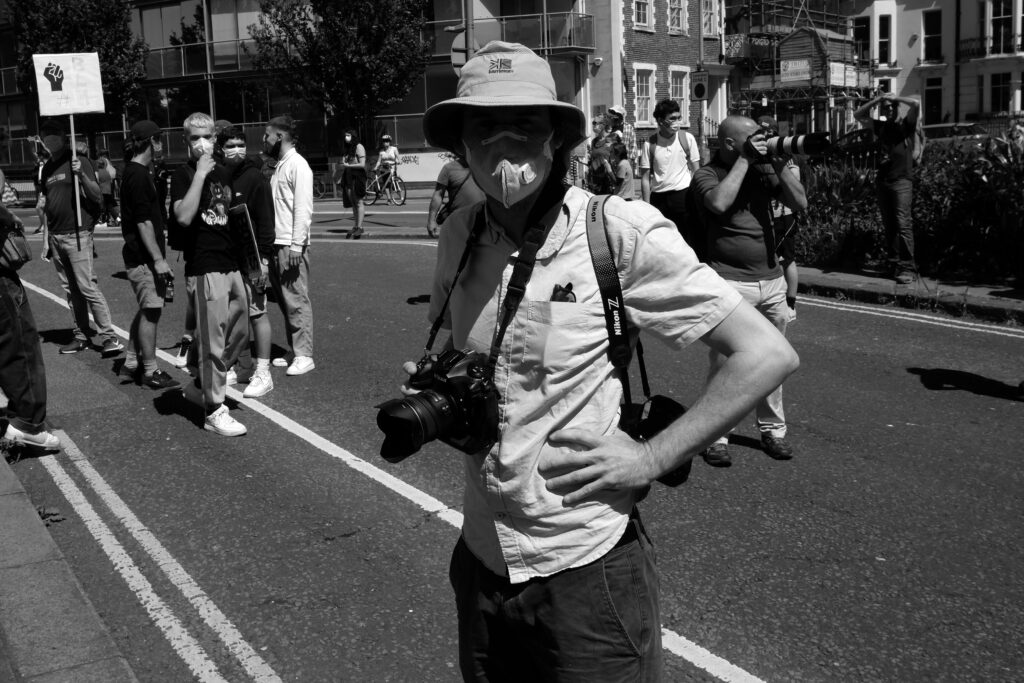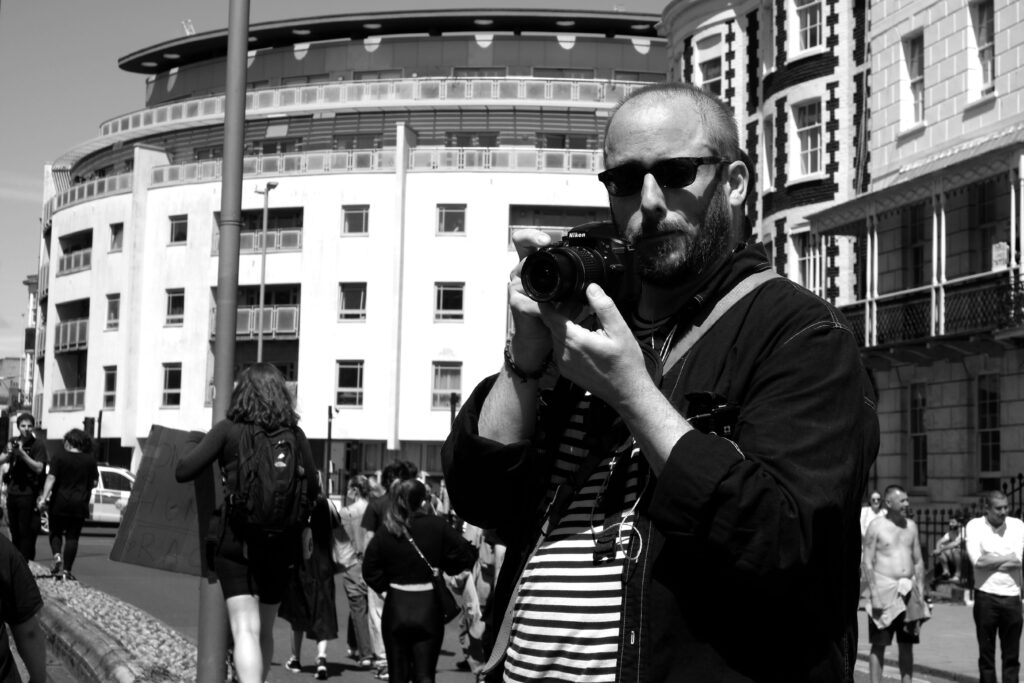For our last instalment of Artist Focus before the Christmas break, I interviewed Jade Hylton, a creative based in Brighton who works in an array of different mediums. From art modelling, to poetry writing, graphic designing and photography, Jade’s creative approach has no limits. In this interview, we discussed her latest project, “White Gaze”, which was a personal response to white privilege in the creative industries, and the tangible disparities between Black and white journalists and photographers during the Black Lives Matter protests in Brighton.
Tell me a bit about your background.
I do a lot of things besides photography. I’m also an artist and writer; I write poetry, I do collage art and digital graphic designs for musicians, such as album artwork. I went to University almost ten years ago, where I studied Digital Media Design. After finishing, I tried to get a job in that area, but everything I found were office jobs, and I really wasn’t the sort of person cut out to work in an office –you know, sitting in a chair and being in one position all the time. So, after I decided that wasn’t something I wanted to do, I started working at Colourstream, a photo lab in Brighton. I worked there for five years, and afterwards I moved to China for five months. After coming back to the UK, I became an art model, which has since then been my primary income.
How did your project “White Gaze” come about?
I came up with the idea on the first Brighton Black Lives Matter protest, which took place on May 3rd. As I was protesting, I noticed how many white media moguls were there. There’s always going to be a heavy press presence on events like this, but with this being such a delicate situation, it was very contradictory to me how a majority of the people documenting what was happening were white men. Even though this march was meant to bring everyone together, I felt that there was a strong segregation taking place in the streets. On one side, there were the protestors –those demonstrating against racial inequalities–, and on the other, there were white spectators, glorifying our pain with their cameras, and photographing the event for projects, social media, newspapers and magazines.
In that moment, I realised that since we were protesting to fight against racial inequality –not just in daily life but also in the work space– it made sense for me to document and show the feelings that these disparities caused me. In order to make a real difference, we need to look at ourselves, and consciously reflect on our actions. Even the smallest details could have an effect on the situation that we are in, preventing progress. My project is therefore about explicitly showing what this ‘segregation’ during the protests meant and what it made me feel. I also felt that this was a shared sentiment; many other people had probably experienced a similar uneasiness, particularly Black people who were trying to capture their own moment and write their own history by protesting.
All these ideas lead me to decide that during the next protest I was going to attend, which took place on June 3rd, I was going to take photos of all the white people who were photographing the Black people. I knew this wasn’t going to be a problem because they already had their cameras out, and since they were already exploiting the situation for their own ends, I didn’t really need to ask for permission to take their pictures.
What do you hope viewers get out of your project?
One of the things I struggled with when I was growing up is that my family, particularly the older generation, like my grandparents, didn’t understand why I wanted to go down the creative route. When they came to the UK as part of the Windrush Generation, they learned to keep their heads down, survive, and make as much money as they could so that their children and grandchildren could live well. Our parents and grandparents never had the opportunity to go to art classes, express themselves creatively, and hope to make a living out of art. Because of this, it can be hard for Black people and people of colour of my generation to be creative, and have our families supporting that choice.
That’s the main message I wanted to convey to white people with my project. I wanted to push white viewers to think about where they came from; why they’ve had the opportunity to own expensive equipment; and why they were able to use it, study it and make a career out of it. Perhaps their parents understand and accept creativity as a profession because they themselves had the chance and financial freedom to express themselves in that way. I want my project to make people ask themselves: “Why do I have this opportunity”, or “Why do Black and people of colour don’t have this opportunity, and how can I help break the cycle?”
I’ve seen that you also work on other artistic mediums, such as collage and videos. What made you decide to approach this topic through photography?
Originally, it was supposed to be an article, but I kept putting it off, until I realised that I didn’t really know how to translate how I felt into words without it sounding it a bit ‘drony’ or moany. So, photography became the ideal medium. It felt like it was going to be more hard-hitting that way. But I also bought a new camera recently, and I wanted to use it as much as possible.
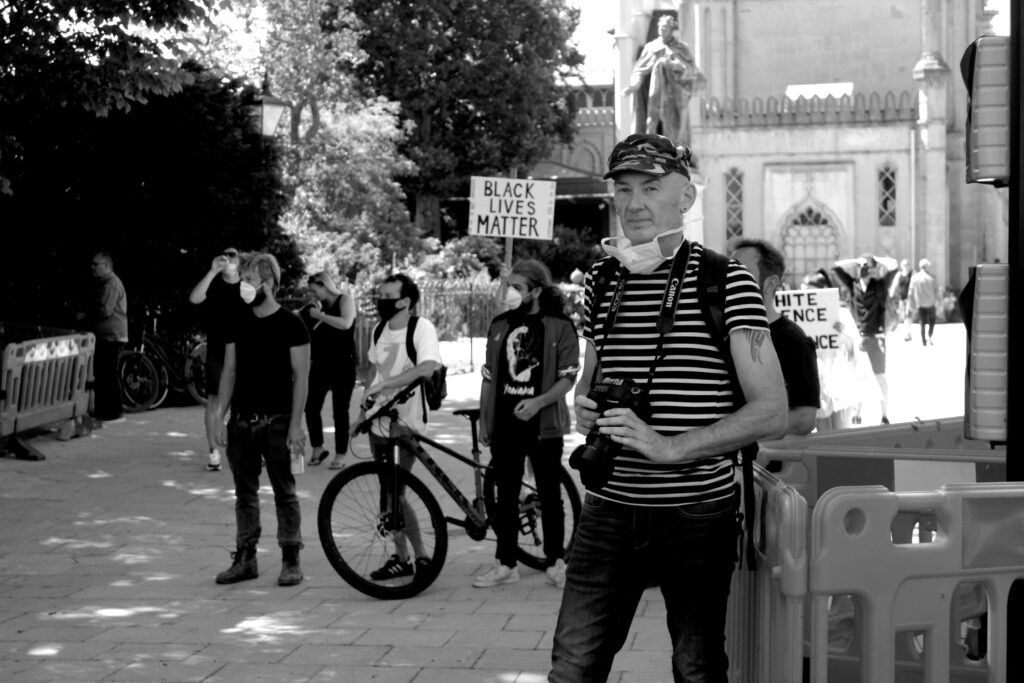
As someone working in the creative industries, how have you managed to combine activism with art?
In a way you could say that I have always incorporated some sort of point of view from my upbringing, my culture and my heritage into my art. A few years ago, I realised that I didn’t have a lot of Black friends and friends of colour, so I made it a mission of mine to actively surround myself more frequently with people with similar backgrounds to mine. When I was out and about –either going out to a pub, or an event– and I saw a Black person, I just asked them if they wanted to be my friend. Because they felt the same way –alienated in a sense–, it was natural for us to start building this little community, which helped us learn more about ourselves, and about our backgrounds. This eventually grew into a creative project in which I decided to take portrait photos of all of them, which is how the “Black Brighton” photography project was born. Later on, I exhibited that project in China, which was my first ever exhibition. The world on the street is that I’m the first Black person to ever exhibit in China. I’m not sure if it’s true, but, that was what was being said when I was over there.
When I returned to the UK I became an art model, and I realised that there wasn’t a lot of Black models or models of colour. In Brighton there were maybe five of us out of two hundred. Since I realised this was another gap in the creative space, I decided to do my own live model class where I would only hire Black people and people of colour, and I would simultaneously try to educate on the history of Black models and artists. This whole project took place during Black History month last year. In addition to this, I also began doing line drawing illustrations, where I would draw Black women with different hairstyles.
Since I’m always trying to educate others about culture, I’ve found that a lot of people can get a bit ‘yawny’ about it. So, by putting a little creative twist on education, I am able to make it more intriguing, inviting and accessible. This way, people are drawn to want to get involved. For me, activism is about trying to do what matters, and if you do it in a creative way, such as art, then everybody else is eventually going to follow.
What are your main sources of inspiration?
I get inspired by pretty much everything. Most of the time, ideas just come to me. I used to actively look out for ideas, but they started emerging naturally after working at Colourstream. When I was there, looking at lots and lots of other people’s projects and photographs, but without being able to do anything to the photos myself, I ended up creating projects in my mind. Thanks to that experience, I’ve been able to get into the motion of creating from nowhere.
What do you hope to achieve in the following year?
At the moment, I got this campaign going on with @finiteediton, who collaborates with artists to create merchandise and give the funds to their chosen charity. Currently, we’re raising money for BMEYPP (Black Minority Ethnic Young People’s Project). We’re selling the t-shirts throughout November, and at the end of the month we will send the funds to the charity.
I’ve also been talking my friend Tendai (@ccushty) about starting our own radio station. Since we have been invited to talk in a lot of radio stations in the past year, we’re hoping to start our own radio station soon.
I would also really like to exhibit “White Gaze” again, so that people can really interact with the project, and hopefully communicate with me as well. Hopefully, after the lockdown, I’ll be able to do that.
Finally, I have also been asked to be part of an anthology of poems that are going to be written by Black Women and non-binary people. The poems will be about race, growing up, love, hate, and everything in between.
To see more of Jade’s work, and to keep up with her projects…
Website: https://jadehyltonphotography.wordpress.com/
Instagram: @the_hylton


